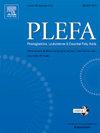出血/再灌注损伤(H/R)的长期复苏刺激肾脏PGE2释放。
IF 2.9
4区 医学
Q3 BIOCHEMISTRY & MOLECULAR BIOLOGY
Prostaglandins, leukotrienes, and essential fatty acids
Pub Date : 1995-06-01
DOI:10.1097/00024382-199506000-00014
引用次数: 0
摘要
本研究探讨了急性出血/再灌注(H/R)损伤后长期高营养复苏(TPN)刺激肾脏释放PGE2的假设。雄性Sprague-Dawley大鼠麻醉后假手术或出血至30mmhg 30 min,再灌注。所有大鼠均给予TPN治疗5 d,然后开腹探查肾动脉和主动脉血流60 min。体外以3ml /min (pH 7.4, 37℃)流速灌注Krebs-Henseleit缓冲液,收集静脉流出物,EIA分析PGE2、6-酮- pgf1 α和血栓素B2。与假手术组相比,出血/再灌注后TPN持续5天使肾脏PGE2增加2倍,体内肾动脉血流量减少50%。出血/再灌注后的TPN并没有改变其他类二十烷酸的释放。这些数据表明,当动物在轻度出血/再灌注损伤后接受TPN长期复苏时,肾脏通过增加PGE2的释放来维持肾血流量的能力有限。本文章由计算机程序翻译,如有差异,请以英文原文为准。
Long-term resuscitation of hemorrhage/reperfusion injury (H/R) stimulates renal PGE2 release.
This study examines the hypothesis that long-term resuscitation with hyperalimentation (TPN) following acute hemorrhage/reperfusion (H/R) injury stimulates renal release of PGE2. Male Sprague-Dawley rats were anesthetized and subjected to sham or hemorrhage to 30 mmHg for 30 min followed by reperfusion. All rats were placed on TPN for 5 days, then underwent laparotomy for in vivo renal artery and aortic blood flow for 60 min. The kidney was perfused in vitro with Krebs-Henseleit buffer at 3 ml/min (pH 7.4, 37 degrees C) and venous effluent was collected for analysis of PGE2, 6-keto-PGF1 alpha and thromboxane B2 by EIA. Hemorrhage/reperfusion followed by TPN for 5 days increased renal PGE2 2-fold and decreased in vivo renal artery blood flow by 50% compared to the sham group. Hemorrhage/reperfusion followed by TPN did not alter release of the other eicosanoids measured. These data suggest that the kidney has a limited capacity to maintain renal blood flow by increasing release of PGE2 when the animal is subjected to long-term resuscitation with TPN following mild hemorrhage/reperfusion injury.
求助全文
通过发布文献求助,成功后即可免费获取论文全文。
去求助
来源期刊
CiteScore
6.40
自引率
6.70%
发文量
60
审稿时长
13.2 weeks
期刊介绍:
The role of lipids, including essential fatty acids and their prostaglandin, leukotriene and other derivatives, is now evident in almost all areas of biomedical science. Cell membrane behaviour and cell signalling in all tissues are highly dependent on the lipid constituents of cells. Prostaglandins, Leukotrienes & Essential Fatty Acids aims to cover all aspects of the roles of lipids in cellular, organ and whole organism function, and places a particular emphasis on human studies. Papers concerning all medical specialties are published. Much of the material is particularly relevant to the development of novel treatments for disease.

 求助内容:
求助内容: 应助结果提醒方式:
应助结果提醒方式:


